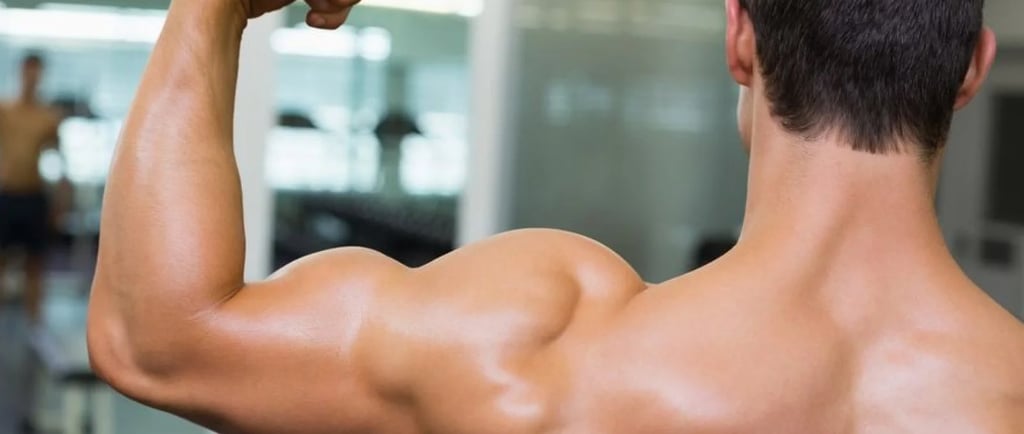Shoulders
The shoulder is a highly mobile joint supported by a complex group of muscles, primarily the Deltoids and the Rotator Cuff.
MUSCLE GROUP
9/28/20253 min read


Shoulders and Workout Variations with Warnings
The shoulders are one of the most versatile and visually impressive muscle groups. Strong, well-developed shoulders create a broad, powerful frame, improve posture, and support nearly every upper-body movement. Beyond aesthetics, the shoulders are highly functional, playing a critical role in lifting, pushing, pulling, and stabilizing the arms during both everyday tasks and athletic performance.
Anatomy of the Shoulders
The shoulder is made up of the deltoid muscles and several supporting structures. The deltoids consist of three distinct heads:
Anterior (front) deltoid – responsible for lifting the arm forward and assisting in pressing movements.
Lateral (middle) deltoid – lifts the arm outward (side raise) and creates shoulder width.
Posterior (rear) deltoid – pulls the arm backward and assists with posture and pulling exercises.
In addition to the deltoids, the rotator cuff muscles (supraspinatus, infraspinatus, teres minor, subscapularis) play a crucial role in stabilizing the shoulder joint and preventing injuries.
Importance of Shoulder Training
Strong shoulders are essential for both functional movement and aesthetics:
Balanced physique – broad, defined shoulders complete the V-shaped upper body look.
Pressing power – key to stronger bench press, push-ups, and overhead press.
Improved posture – rear deltoids and rotator cuff muscles counteract slouching.
Injury prevention – strong shoulders reduce risk of strains during sports and lifting.
Functional strength – used in pushing doors, carrying objects, throwing, or reaching overhead.
Neglecting shoulders often leads to weakness, rounded posture, and imbalances that increase the risk of injury.
Shoulder Workout Variations
Here are some effective shoulder exercises that target different heads of the deltoids and supporting muscles:
1. Overhead Press (Barbell or Dumbbell)
Hold weights at shoulder level, palms forward.
Press overhead until arms are fully extended.
Lower slowly to start position.
👉 Builds overall shoulder mass and pressing strength.
2. Arnold Press
Hold dumbbells at shoulder height, palms facing you.
As you press overhead, rotate palms forward.
👉 Engages all three deltoid heads, especially front.
3. Lateral Raises
Hold dumbbells by your sides.
Raise arms outward to shoulder height, elbows slightly bent.
👉 Best isolation for the lateral deltoids.
4. Front Raises
Hold dumbbells or a plate in front.
Raise arms forward until shoulder height.
👉 Targets anterior deltoids.
5. Rear Delt Flys
Bend forward slightly, holding dumbbells.
Raise arms outward until parallel with shoulders.
👉 Strengthens posterior deltoids for balance and posture.
6. Upright Rows
Hold a barbell or dumbbells in front of thighs.
Pull up toward chin, elbows leading the motion.
👉 Works lateral delts and traps.
7. Face Pulls (Cable or Band)
Attach rope handle at face level.
Pull rope toward forehead, elbows high.
👉 Strengthens rear delts and rotator cuff muscles.
8. Handstand Push-Ups (Advanced)
Against a wall, lower yourself into a push-up while inverted.
Press back up.
👉 Excellent bodyweight strength builder for shoulders.
9. Push Press
Similar to overhead press, but use slight leg drive.
Press weight explosively overhead.
👉 Builds power and engages the entire body.
Warnings and Safety Tips
The shoulder joint is highly mobile but also one of the most unstable in the body. Training without proper care can easily lead to injuries such as impingement, rotator cuff tears, or joint pain. Follow these warnings for safe shoulder development:
1. Warm Up Thoroughly
Do dynamic stretches and light mobility drills before heavy presses or raises. Cold shoulders are prone to injury.
2. Protect the Rotator Cuff
Incorporate exercises like face pulls and external rotations to strengthen the rotator cuff and maintain stability.
3. Avoid Excessive Heavy Upright Rows
Using very heavy weight with upright rows can pinch the shoulder joint. Keep form strict and moderate.
4. Don’t Overtrain the Front Delts
Pressing movements (bench press, push-ups) already target front delts. Balance training by focusing more on lateral and rear delts.
5. Maintain Proper Range of Motion
Don’t swing weights or overextend joints. Controlled movements protect tendons and joints.
6. Watch Out for Pain
Sharp pain, especially at the front of the shoulder, can indicate impingement. Stop immediately and adjust your form or exercise choice.
7. Progress Gradually
Increase weight over time rather than rushing into heavy presses. Shoulders respond well to moderate weights and higher reps.
8. Balanced Training
Always pair pushing (pressing) movements with pulling (rows, rear delt flys) to prevent muscular imbalances.
9. Use Proper Equipment and Grip
Grip too narrow or too wide on presses can strain joints. Adjust to shoulder-width for safety.
10. Rest and Recovery
Shoulders are engaged in chest, triceps, and even back workouts. Allow at least 48 hours before directly training them again.
Final Thoughts
The shoulders are one of the most important muscle groups for both strength and aesthetics. Strong, well-rounded deltoids improve posture, enhance pressing power, and create the coveted V-taper physique. With exercises like overhead presses, lateral raises, rear delt flys, and face pulls, you can effectively target all three heads of the deltoid and supporting muscles.
However, due to their mobility, shoulders are vulnerable to overuse and injury. Proper warm-up, balanced training, and careful progression are key. By combining compound presses with isolation work, protecting the rotator cuff, and respecting recovery, you can build powerful, stable, and healthy shoulders that support your fitness journey long-term.
